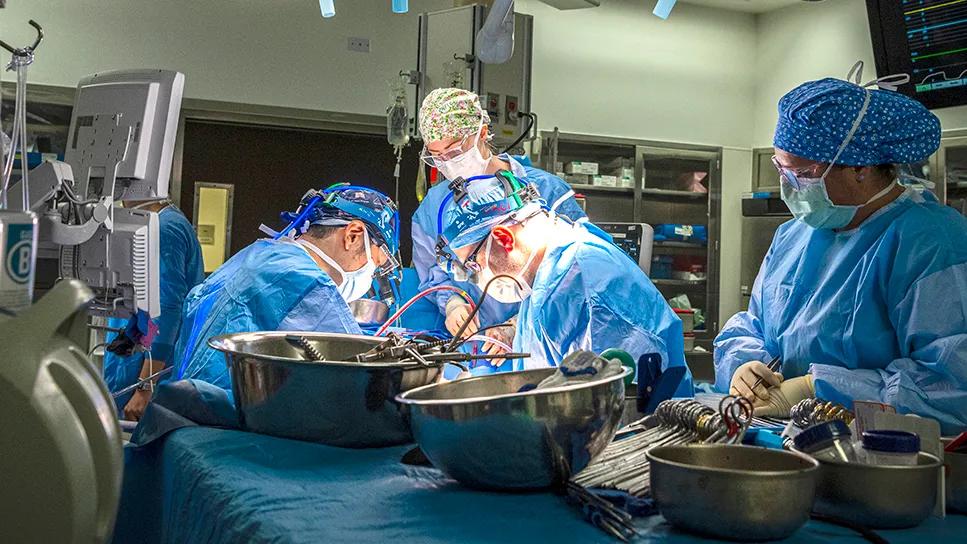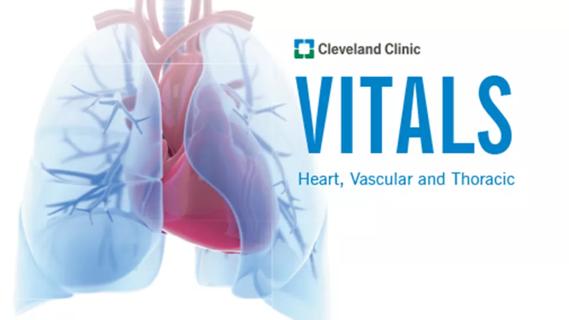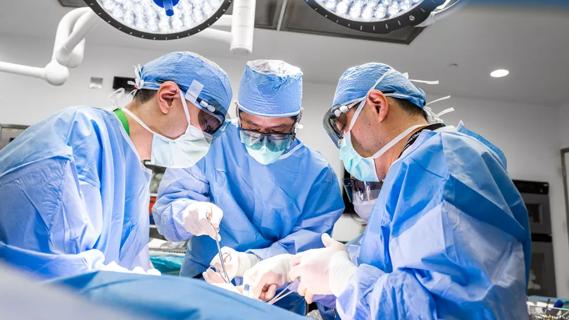Launch of the tool promises to reshape quality assessment across the specialty

As cardiac surgery evolves through advancements in techniques and increasingly complex patient profiles, the need for robust and adaptable quality assessment tools is greater than ever. In response, the American Association for Thoracic Surgery (AATS) has developed the AATS Quality Gateway (AQG), a new platform designed to provide a comprehensive and contemporary approach to evaluating outcomes across the spectrum of all adult cardiac surgery. This initiative — in which Cleveland Clinic cardiothoracic surgeons have played a lead role — promises a new age of quality improvement by offering insights that current outcome models have been unable to fully capture, including the Society of Thoracic Surgeons (STS) Adult Cardiac Surgery Database, which scores outcomes of five heart operations.
Advertisement
Cleveland Clinic is a non-profit academic medical center. Advertising on our site helps support our mission. We do not endorse non-Cleveland Clinic products or services. Policy
For years, cardiac surgeons have grappled with the limitations of existing national outcome prediction models, particularly when dealing with complex procedures like thoracic aortic operations or surgeries on patients with “nonstandard” profiles. The very definition of a “standard” patient has been questioned, underscoring the need for a more encompassing system. While the STS has provided valuable guidance, its models have struggled to account for the intricacies of multicomponent operations, reoperations and less-common surgical procedures. This gap has hindered effective quality control and comparisons across surgeons and institutions.
AATS leadership felt there was a need for a more efficient and modern way of assessing cardiac surgery outcomes. The concept of AQG took shape at the 2019 AATS Annual Meeting, driven by a proposal to create what its proponents described as a “de novo, 21st-century quality assessment program.” The vision was to develop a system with minimal data collection that leveraged advanced machine learning to predict mortality and morbidity after all adult cardiac surgeries with the exception of heart transplants and LVAD implantations. The goal would be to provide surgeons, patients, hospitals and health systems with actionable information for quality assurance. Cleveland Clinic’s Eugene Blackstone, MD, an international leader in statistical analysis and model development in cardiothoracic surgery, teamed with Hemant Ishwaran, PhD, from the University of Miami, to spearhead this initiative to create a modern, adaptable program.
Advertisement
Efforts began with compilation of a database of 52,792 adult cardiac operations performed across 19 hospitals within three high-performing health systems — Cleveland Clinic, Mount Sinai in New York, and Columbia University — between July 2014 and January 2023. These data were used to train an algorithm to perform risk-adjusted outcomes prediction with advanced machine learning to create virtual twins for comparison. The resulting “Blackstone-Ishwaran algorithm” generates predictions of mortality and morbidity across all adult cardiac surgery procedures, including complex multicomponent operations and reoperations.
The AQG outcome models, whose development is described in a recent literature publication (J Thorac Cardiovasc Surg. 2025;169:824-832), underwent subsequent validation, including in two recently published analyses (J Thorac Cardiovasc Surg. 2025;169:833-842 and J Thorac Cardiovasc Surg. 2025 Epub 5 Feb).
The first study tested the outcomes of a single cardiac surgeon (Lars Svensson, MD, PhD) at Cleveland Clinic across 24 types of cardiac operations from late 2001 to early 2023. The second study, published by a team of Cleveland Clinic surgeons, provides particularly useful insight by testing the AQG model’s performance using this same surgeon’s extensive aorta surgery experience. Analyzing 6,923 aortic procedures performed by this surgeon during the same 21-year period, the study compared AQG-predicted operative mortality (based on the training set’s 52,792 operations from 2014 to 2023) with observed mortality over time. The model was able to delineate various procedures based on the extent of the repair, providing risk scores tailored to specific interventions such as aortic root replacement, ascending aorta replacement, hemiarch replacement and repairs involving different aortic zones.
Advertisement
“That level of granularity and versatility had previously been unattainable,” says Cleveland Clinic cardiothoracic surgeon Marijan Koprivanac, MD, MS, first author of the analysis. “It represents a significant step forward in cardiac surgery outcomes assessment.”
The analysis revealed the AQG model’s ability to track changes in the surgeon’s case volumes and complexity. “AQG performed admirably,” the study authors write, “showing estimated mortality of all forms of thoracic aorta surgery for the first time.”
Notably, while AQG-expected mortality was lower than observed mortality in the early part of the 21-year study period, it was higher than the observed mortality from 2010 onward. “This reflects the evolution of practice and the fact that the AQG model is based on post-July 2014 data, and it does not take into account improvements in technique from 2001 to July 2014,” notes Dr. Koprivanac. “During the earlier period, a higher proportion of complex and high-risk patients underwent open surgery since this was before transcatheter aortic valve replacement and more widespread use of hybrid procedures and endovascular approaches to the aortic arch and thoracic aorta.”

Importantly, even when looking at the 2001-2013 outcomes through the lens of 2014-2023 data modeling, observed overall mortality was better than the contemporary AQG-expected mortality several years in advance of 2014. This suggests that improvements in the surgeon’s aortic surgical techniques were already leading to better outcomes prior to the AQG model’s data training period. In more homogeneous, lower-risk populations, such as those undergoing isolated aortic valve repair or isolated ascending aorta procedures, observed and AQG-expected mortality showed a mostly linear distribution, with AQG often predicting a slightly higher risk.
Advertisement
Now that the AQG models have been developed and validated, dissemination for broad adoption is a priority. To lead that charge, the AATS Board of Directors has tapped Cleveland Clinic cardiothoracic surgeon Edward Soltesz, MD, MPH, as Chief Medical Officer of AQG. In this role, Dr. Soltesz is focused on finalizing AQG product development and disseminating the AQG platform with the goal of making it the new standard registry for cardiac surgery. He and AATS are actively promoting AQG through presentations at meetings and webinars to educate the cardiac surgery community.
In doing so, Dr. Soltesz identifies what he sees as several advantages of AQG models over traditional quality tools from the STS:
Advertisement
Currently, the general AQG model is operational in nearly 50 hospitals, including major centers (Cleveland Clinic among them). Deployment of institution-specific models is underway and will be contingent on hospitals uploading data from prior years to generate the model.
Moving forward, AATS and Dr. Soltesz have no shortage of ideas for new features and refinements for AQG. These include the introduction of valve disease registries as well as a module for longitudinal follow-up that will use artificial intelligence algorithms to help institutions do long-term patient follow-up without the need to always directly contact patients.
“Our vision is for AQG to become an indispensable tool,” Dr. Soltesz concludes. “For surgeons, it requires a very small footprint for data collection and provides rapid outcomes feedback at an institution-specific level. For patients, it provides risk estimates for many cardiac operations for which they previously couldn’t get estimates. For institutions, it offers a new way for quality officers to identify variance in outcomes according to risk profiles.”
“AQG should allow cardiac surgeons for the first time to look at every aspect of all the surgeries we do and evaluate our outcomes against a nuanced benchmark,” adds Dr. Koprivanac. “This will be key to improving the quality of care for our patients.”
Advertisement

Check out our latest volume and outcomes data in these key areas

New research indicates feasibility and helps identify which patients could benefit

Check out our latest volumes and outcomes data

Our latest volume and outcomes data in infographic form

Ideation session generates solutions to medication administration errors

Experts advise thorough assessment of right ventricle and reinforcement of tricuspid valve

Caregivers spearhead changes that improve patient care, shape hospital culture

Findings could help clinicians make more informed decisions about medication recommendations